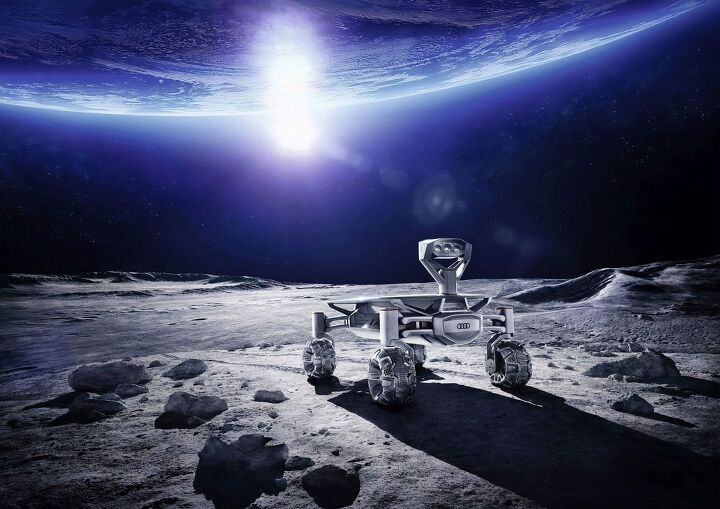Audi Vehicle Packs Its Bags, Books Ticket to the Moon

It’s a one-way flight, obviously.
Audi has announced that its Lunar Quattro has a ticket to ride on a moon-bound spaceflight booked for late next year. Refined, finessed, and now 18 pounds lighter, the automaker’s plucky moon rover is bound for a rendezvous with another extraplanetary car.
That one, however, is a 1970s model.
Since Audi announced its desire to land a four-ring rover on the moon early last year, 16 of its top experts have put their brains together assembling a battery-powered lunar vehicle equipped with sure-footed all-wheel drive. Moon dust, as we all know, is terrible for traction.
It’s not boredom that’s compelling Audi to make this trip. The automaker, working with the German space travel company Part-Time Scientists, hopes to beat out 15 competing teams to win the Google Lunar XPRIZE. To win, a team must land a rover on the moon, drive it a minimum of 500 meters (about a third of a mile), and send back photos.
To make up for the cost of development, the prize includes a $30 million payday. Not bad, but spaceflight ain’t cheap.
With two 66.1-pound Audi Lunar Quattros at the ready, all that’s left is the trip. And it’s a loooong trip — 385,000 kilometers, or about 240,000 miles. Yesterday, the automaker announced that PT Scientists has secured a launcher booked through Spaceflight Inc., which should lift off near the end of 2017. Space News reports that the launch vehicle will almost certainly be a SpaceX Falcon 9 booster, which is how Elon Musk worms his way into this story.
Unlike a NASA mission, the Google Lunar XPRIZE doesn’t concern itself with mineral samples and the effects of weightlessness on tiny screws in space. Simply, the mission is all about getting there, period.
Still, the Audi team doesn’t plan to ignore space history or science. There’s extra room in the probe, so the team plans to ship equipment for NASA, the European Space Agency and Wikipedia. Also, the two rovers are headed to meet up with a relic of the past — the Apollo 17 Lunar Rover left behind in the Valley of Taurus-Littrow after the last manned moon mission in 1972. That vehicle was built with the help of General Motors.
[Image: Audi AG]

More by Steph Willems
Latest Car Reviews
Read moreLatest Product Reviews
Read moreRecent Comments
- SCE to AUX "...if there’s enough demand"If they are only offered as electric to begin with, how will Stellantis gauge demand - unhappy customers demonstrating at the dealers with torches and pitchforks?What a great way to add cost and reduce competitiveness, by making a propulsion-agnostic platform with a hundred built-in compromises.
- FreedMike Awfully nice car.
- Cprescott So is this going to lie and tell you that they have quality products at affordable costs that won't get recalled?
- SCE to AUX So they might continue gigacasting 3 pieces instead of 1. Tesla does gigacasting as a business advantage, so they aren't abandoning it. They probably ran into some tech challenge related to integrating 3 pieces into 1, so 3 will do.Meanwhile Toyota and several Chinese mfrs are adopting gigacasting because of Tesla.
- Tassos Great Choice, far better than an ES350. I prefer one size larger and a V8 as in the LS460, but it is probably not as agile as the GS.And thus spake the REAL TASSOS.


































Comments
Join the conversation
Better an Audi on the moon than a Lexus in Uranus, I'd say...
But why? Also, audis don't even last the entirety of their lease period without electronic failures; I doubt they'll survive the ~250,000 mile trip to the moon.